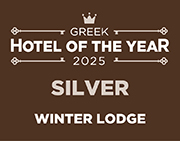We have always enjoyed welcoming our friends to our family house in our home village. And their friends. And their friend’s friends. Friends we had not yet met. Looking back, they are surely a few hundred people. For a few days, a weekend, or for just one night. And then, of course, there is the carnival, which always makes the average number of visitors go through the roof.
Then we started to spend more and more time here. We started to work from here. Even before the pandemic “favored” working from home.
We traveled all around mountainous Gortynia, through a vast series of landscapes. From the dense forests of firs, reaching down to the more typical Mediterranean environment. A truly magical place that offers an unexpected natural diversity to the visitor and traveler.
There is also the human footprint, which can either elevate or shatter a place. The villages of Mount Menalon are considered such an example. A case study of how the people built into their place and of how the mountains have forged those very same people.
Then there was the house belonging to our grandparents as well. In the middle of a neighborhood where everyone stopped to take photos but where all houses were in ruins. Ruins have a beauty of their own, but a living home is much better. That’s the story of how the house turned into a guesthouse.
Imbued by respect for our land’s tradition, we restored the house, bringing it back to its original form, thus making the residence regain its initial form as much as possible. The innovative elements were not difficult to decide on.
The traditional houses of Lagadia are not bioclimatic. Bioclimatic architecture tries to apply the knowhow of “olden days” to modern structures. We simply made sure the house was weatherproofed.
All that follows comes naturally. If tourism does not contribute to the multifaceted growth of a place, then both the place and tourism will perish. It is a known fact that monoculture leaves a barren land. Thus, we want to return to the land what we make off it, by offering local (or, if not possible, fair-trade) products and supporting local festivities and actions (3% of our revenue) and by saving on energy and water consumption as well as waste production. That is, through what the experts call “responsible tourism”.
So, what if a car cannot get right in front of the very entrance of the guesthouse. That is the case for most traditional villages. Is there anything better than walking up the cobbled street to grab some coffee or a traditional delicious cheese-pie? Maybe there is! Perhaps a tipsy, tumbling return with a full stomach from the main square or the taverna sounds even better.
What about the children? What will they do all day? You will be surprised with what they can get up to if left to roam the car-free village…
We traveled all around mountainous Gortynia, through a vast series of landscapes. From the dense forests of firs, reaching down to the more typical Mediterranean environment. A truly magical place that offers an unexpected natural diversity to the visitor and traveler.
There is also the human footprint, which can either elevate or shatter a place. The villages of Mount Menalon are considered such an example. A case study of how the people built into their place and of how the mountains have forged those very same people.
Then there was the house belonging to our grandparents as well. In the middle of a neighborhood where everyone stopped to take photos but where all houses were in ruins. Ruins have a beauty of their own, but a living home is much better. That’s the story of how the house turned into a guesthouse.
Imbued by respect for our land’s tradition, we restored the house, bringing it back to its original form, thus making the residence regain its initial form as much as possible. The innovative elements were not difficult to decide on.
The traditional houses of Lagadia are not bioclimatic. Bioclimatic architecture tries to apply the knowhow of “olden days” to modern structures. We simply made sure the house was weatherproofed.
All that follows comes naturally. If tourism does not contribute to the multifaceted growth of a place, then both the place and tourism will perish. It is a known fact that monoculture leaves a barren land. Thus, we want to return to the land what we make off it, by offering local (or, if not possible, fair-trade) products and supporting local festivities and actions (3% of our revenue) and by saving on energy and water consumption as well as waste production. That is, through what the experts call “responsible tourism”.
So, what if a car cannot get right in front of the very entrance of the guesthouse. That is the case for most traditional villages. Is there anything better than walking up the cobbled street to grab some coffee or a traditional delicious cheese-pie? Maybe there is! Perhaps a tipsy, tumbling return with a full stomach from the main square or the taverna sounds even better.
What about the children? What will they do all day? You will be surprised with what they can get up to if left to roam the car-free village…





